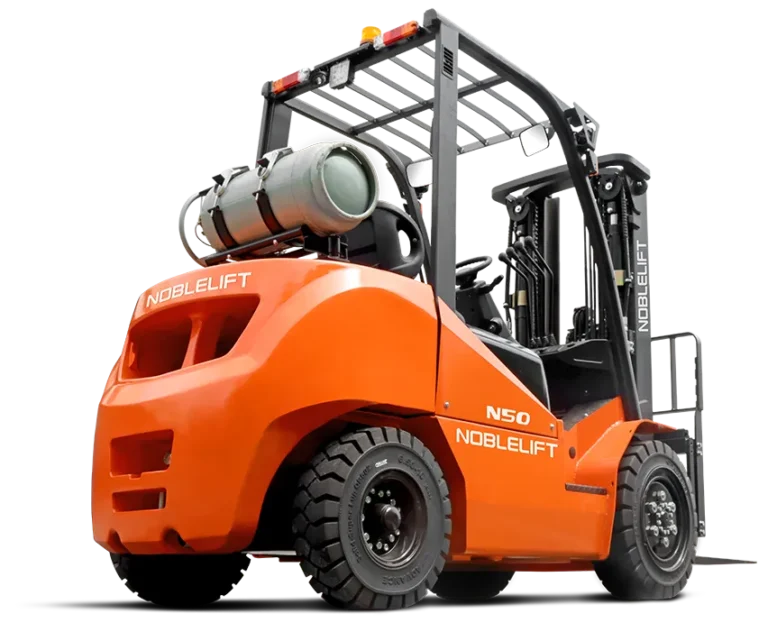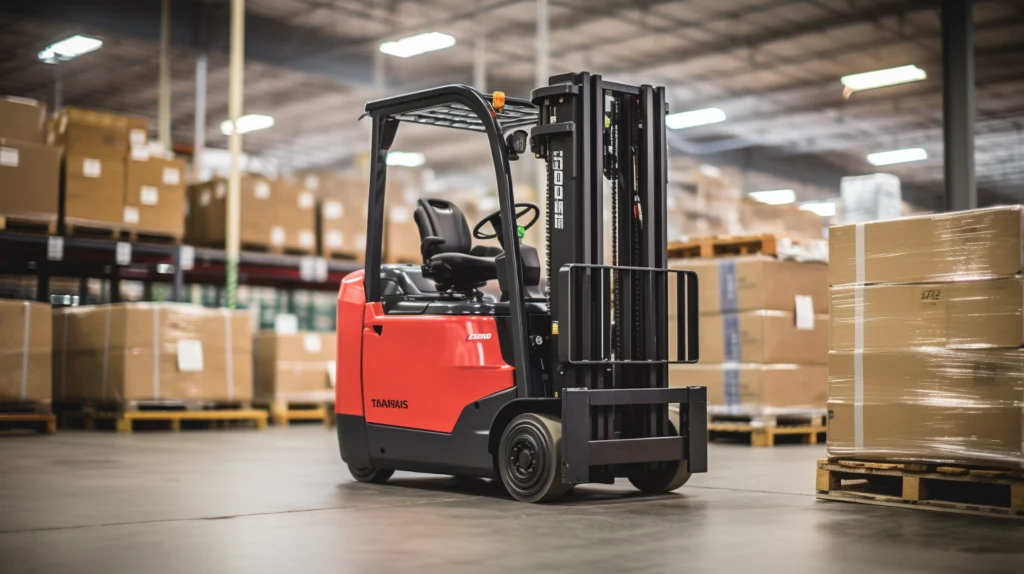
Lithium forklift batteries are reshaping the material handling industry, shifting priorities towards efficiency, safety, and sustainability. No longer dominated by traditional lead acid batteries, the introduction of lithium-ion technology offers enhanced power solutions with impacts on operational efficiency, cost implications, environmental considerations, and workplace safety. Embracing this transformative era is more than just adopting new technology—it’s about understanding its profound influence on the industry’s future.
Key Points:
- Lithium vs. Lead Acid: Lithium batteries offer superior charging, lifespan, and efficiency for forklifts.
- Environmental Impact: Proper recycling of lithium batteries mitigates ecological concerns.
- Cost Savings: Lithium batteries lead to fewer charges, lower maintenance, and increased productivity.
- Future Trend: Lithium batteries represent the future of the forklift industry, emphasizing sustainability.
- Informed Choices: Battery decisions impact safety, costs, and the environment in material handling.
The Evolution of Forklift Batteries
The story of forklift batteries is a journey that mirrors the technological and operational advancements in the material handling industry. From humble beginnings, these batteries have become the heart of countless operations, ensuring the seamless movement of goods in warehouses, factories, and beyond.
Traditional Lead Acid Batteries: A Pillar in the Material Handling Industry
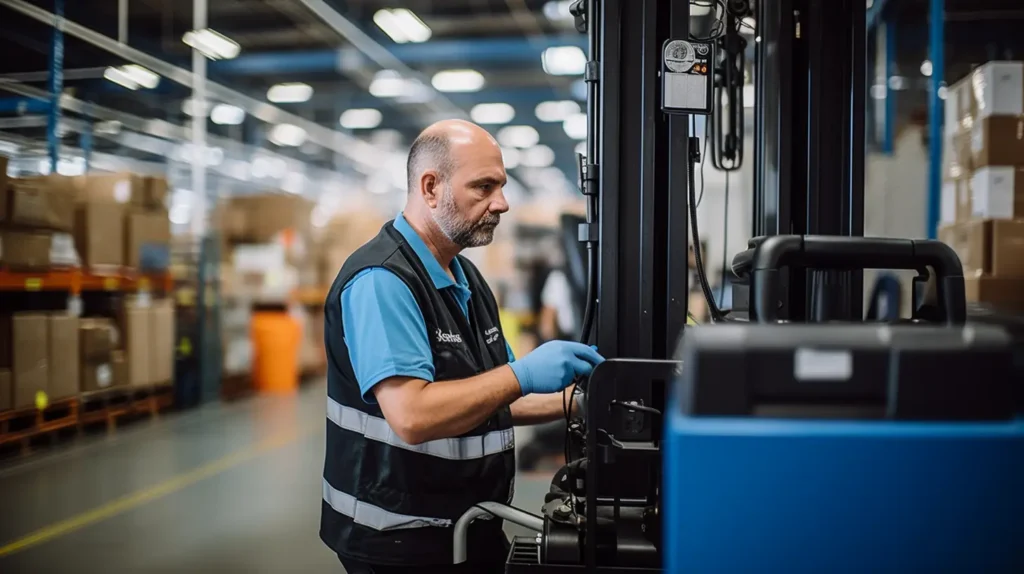
Lead acid batteries, often recognized by their hefty weight and the distinct cells filled with a mix of sulfuric acid and water, have been the backbone of electric forklift operations for over a century. Their historical significance is profound.
These batteries balanced affordability and functionality, making electric forklifts a viable option for businesses of various scales. The typical battery discharges during operations and requires around 8 hours to charge, with an additional 8 hours for cooling. Their energy storage mechanism, a chemical process involving lead plates, sulphuric acid, and the subsequent production of electrons, has been relied upon for consistent power delivery.
Moreover, lead acid batteries played a pivotal role in shaping the early dynamics of the material handling industry. They heralded a new age of quieter, emission-free indoor operations, replacing the noisy, fume-belching internal combustion forklifts. Their consistent power output, combined with their robustness, made them the default choice for many industries.
The Rise of Lithium Ion Technology: A New Chapter in Material Handling
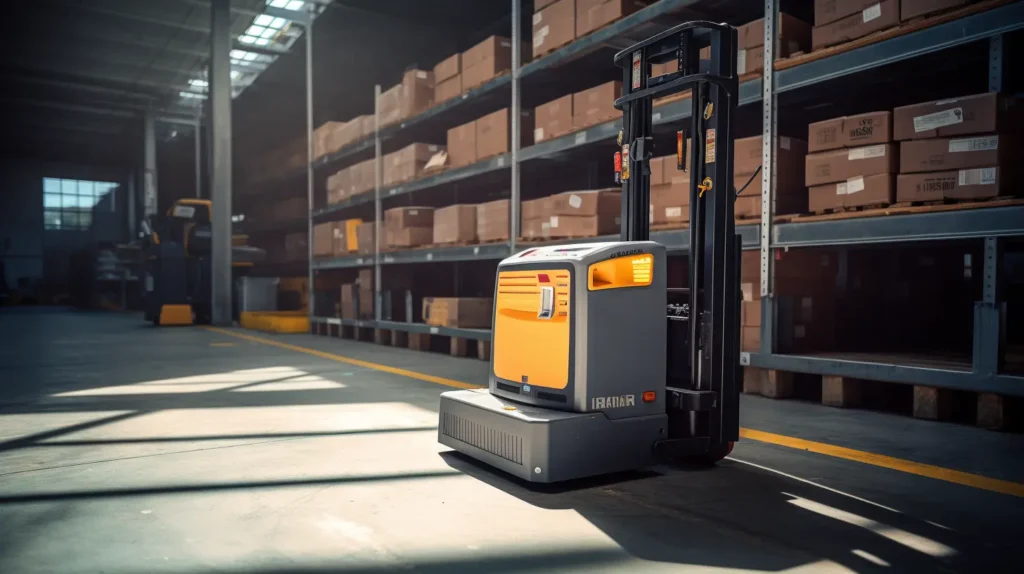
Enter the modern material handling industry, where the emphasis on rapid operations, energy efficiency, and minimal downtime is stronger than ever. While reliable, the traditional lead acid batteries began to show their age.
Charging times, maintenance needs, such as topping up with distilled water, and the required battery rooms with ventilation for safety became challenges in the fast-paced contemporary warehouse environment.
Lithium-ion technology, which had already revolutionized consumer electronics with its compact size and longer life cycles, began its foray into the forklift industry. Lithium forklift batteries presented a compelling case with the ability to be opportunity-charged during breaks and shifts, eliminating the need for extended downtime or multiple batteries. Their energy-efficient nature, longer lifespan of up to 10 years, and reduced environmental impact made them an attractive alternative.
Furthermore, lithium-ion batteries have advanced battery management systems, providing real-time data, optimizing performance, and ensuring safety. Their adoption symbolizes a technological upgrade and a fundamental shift in how the material handling industry views power management and operational efficiency.
The Chemistry Behind the Batteries
When delving into the world of batteries, especially those pivotal to the functioning of forklifts, it becomes imperative to understand the chemistry that fuels their operation. The way a battery stores and releases energy is intrinsically linked to the chemical processes within its confines. Let’s embark on a journey to explore these processes for both lead-acid and lithium-ion batteries.
Lead Acid Batteries: A Time-Tested Chemistry

At the core of lead acid batteries lie three fundamental components: sulphuric acid, lead plates, and water. These batteries operate on a simple yet effective principle:
Sulphuric Acid & Water: The battery contains a diluted sulphuric acid solution. This solution plays a pivotal role in facilitating the flow of ions during the charge and discharge cycles.
Lead Plates: Within the battery, there are two types of lead plates: the positive plates made of lead dioxide and the negative plates made of sponge lead.
Energy Storage Mechanism: When the battery discharges, the lead dioxide (positive plate) and sponge lead (negative plate) react with the sulphuric acid, producing lead sulphate and water. This chemical reaction releases electrons, which flow through a connected device, providing power.
Conversely, during charging, the process is reversed. An external electrical source causes the lead sulphate to dissociate, regenerating lead dioxide and sponge lead and re-concentrating the acid.
Lithium Ion Batteries: Modern & Efficient Chemistry
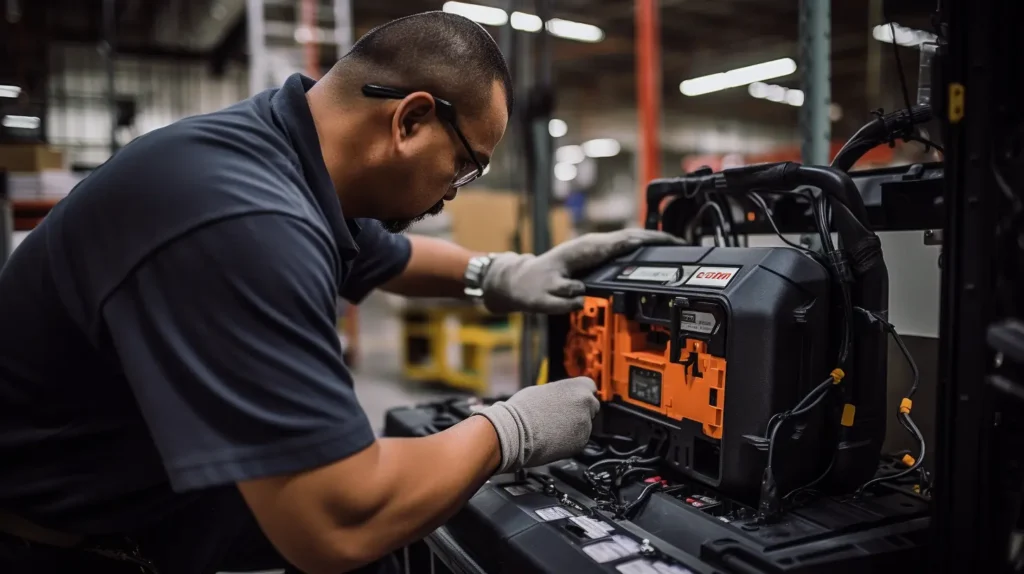
Lithium-ion batteries signify a departure from traditional battery chemistry. They utilize:
Lithium Compounds: Different lithium compounds are used as the cathode depending on the specific type of lithium-ion battery. Common ones include lithium cobalt oxide (LiCoO2) and lithium manganese oxide (LiMn2O4). These compounds are chosen for readily accepting and releasing lithium ions.
Energy-Efficient Design: One of the standout features of lithium-ion batteries is their energy density, which is significantly higher than that of lead-acid batteries. This allows them to store more energy in a smaller space.
Chemical Process: In a lithium-ion battery, during discharge, lithium ions move from the anode (usually made of graphite) to the cathode (like lithium cobalt oxide), releasing energy. When charging, these ions move back to the anode. The movement of these ions, facilitated by an electrolyte, allows the battery to store and release energy.
Advantages of Using Lithium Ion Batteries in Forklifts
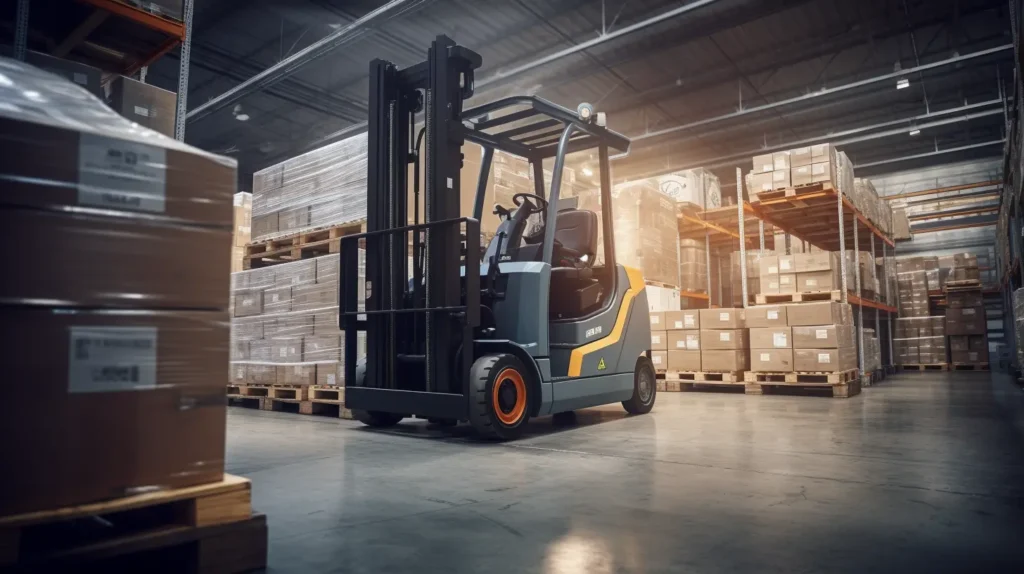
The transition from traditional lead acid batteries to lithium-ion technology in the material handling industry wasn’t merely a whimsical decision. It was driven by lithium-ion batteries’ tangible advantages, mainly when employed in forklifts. Let’s explore these advantages and why lithium-ion has rapidly become the preferred choice for many operators and businesses.
Longer Life Expectancy: A Sustainable Investment
When businesses make decisions about equipment and infrastructure, longevity is a prime concern. In this arena, lithium-ion batteries shine:
Extended Cycle Life: A typical lithium-ion battery can outlast its lead-acid counterpart considerably. While a lead acid battery might offer 500-1000 charge/discharge cycles, a lithium-ion forklift battery can boast up to 2000-5000 cycles, making it a more sustainable investment in the long run.
Consistent Performance: As lead acid batteries age, their capacity diminishes, which is not true with lithium ions. Even after numerous charge cycles, lithium forklift batteries retain a high percentage of their original capacity, ensuring consistent forklift performance over the years.
Enhanced Safety with Advanced Features
Safety is paramount in any industrial setting, and here, lithium forklift batteries bring a slew of benefits:
Battery Management System (BMS): This integrated system continuously monitors and manages the battery’s performance, ensuring optimal charge levels, preventing overcharging, and averting potential hazards.
Reduced Safety Hazards: Unlike lead acid batteries, which involve handling sulphuric acid, potential spilling hazards, and the need for personal protective equipment, lithium-ion batteries are essentially maintenance-free and present fewer safety concerns.
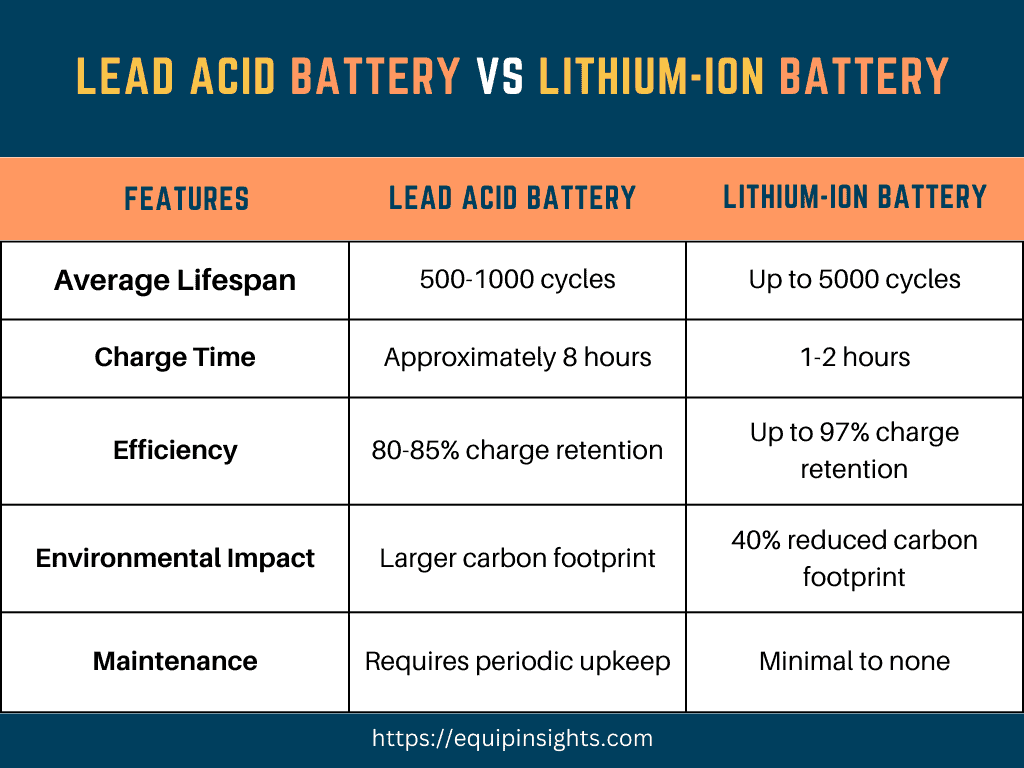
Energy Efficiency: Good for the Pocket and the Planet
Lithium-ion batteries aren’t just about longevity; they’re also about efficient energy utilization:
Higher Energy Density: These batteries can store more energy per unit volume than traditional lead acid batteries. This translates to longer run times and fewer interruptions for charging, optimizing forklift operations.
Rapid Charging: Lithium forklift batteries can charge more quickly than lead acid counterparts. Where a lead acid battery might need 8 hours to charge fully, a lithium-ion battery can achieve a significant charge in just a few hours, reducing downtime.
Unparalleled Charging Convenience
Beyond just the speed of charging, there’s an ease and convenience to the process that lithium-ion batteries introduce:
Opportunity Charging: Unlike lead acid batteries, which often require a complete discharge before recharging, lithium-ion batteries can be opportunistically charged during breaks or shifts without affecting lifespan. This flexibility can be a game-changer in multi-shift operations.
No Special Charging Rooms Required: Lead acid batteries often need dedicated charging rooms with ventilation due to the release of hydrogen gas during charging. Lithium-ion batteries, devoid of such requirements, simplify the infrastructure needs.
Potential Hazards and Precautions

While the benefits of batteries in the material handling industry are undeniable, they come with their hazards. Awareness of these risks and taking the necessary precautions can drastically reduce accidents and injuries. This section delves into the potential dangers of lead-acid and lithium-ion batteries and provides recommendations for ensuring a safe working environment.
Dangers of Lead Acid Batteries
Lead acid batteries have been a staple in the forklift industry for decades. However, they come with their own set of hazards:
Sulfuric Acid Contact: One of the primary components of lead acid batteries is sulfuric acid. This potent acid can cause severe burns upon contact with the skin, leading to injuries. In a spill or battery rupture, this acid can be particularly hazardous.
Gas Emissions: Lead-acid batteries release hydrogen gas during the charging process. In confined spaces, this can lead to an accumulation of hydrogen, posing a risk of explosions if ignited.
Hazards of Lithium Ion Batteries
Lithium-ion batteries, while more modern, aren’t without their risks:
Thermal Runaway: This refers to a chain reaction inside the battery that rapidly releases stored energy, potentially causing the battery to explode or catch fire.
Overcharging Risks: If not properly managed, lithium-ion batteries can overheat during charging, which can cause fires or explosions. The integrated Battery Management System (BMS) in most modern lithium-ion batteries helps mitigate this risk, but malfunctions are always possible.
The Vital Role of Personal Protective Equipment (PPE)
Ensuring safety in the workplace isn’t just about understanding risks—it’s about being prepared:
For Lead Acid Batteries: Given the risks of sulfuric acid, workers handling or maintaining these batteries should always wear protective gloves and safety goggles. Acid-resistant aprons and face shields can offer additional protection during maintenance or in case of spills.
For Lithium Ion Batteries: While there’s no risk of acid spills, wearing gloves and safety goggles is still recommended, especially during maintenance, to protect against potential battery leaks or ruptures.
Recommendations for Safe Charging
Given the hazards, especially those associated with gas emissions and potential battery malfunctions, there are specific safety measures industries should adopt:
Hydrogen Sensors in Charging Rooms: Especially vital for lead acid batteries, installing hydrogen sensors can detect elevated levels of the gas, alerting workers to potential risks and preventing explosions.
Ventilation: Charging rooms should be well-ventilated to dissipate any gases emitted during the charging process, reducing explosion risks.
Regular Maintenance Checks: Inspecting batteries for any signs of wear, damage, or malfunction is essential. This includes checking for bulges, leaks, or other irregularities in lead-acid and lithium-ion batteries.
Battery Life and Charging Dynamics

In the vast material handling arena, the heart of an electric forklift’s operation rests in its battery. The battery’s life, charging dynamics, and efficiency directly affect a forklift’s performance, operation cost, and warehouse operations’ overall efficiency. Let’s delve deeper into these dynamics and understand how they shape the world of electric forklifts.
The Dynamics of Battery Discharge
At the crux of battery operations lies its discharge mechanism. Every battery, whether lead acid or lithium-ion, has a specific energy storage capacity, represented in battery voltage and power.
Battery Voltage: This denotes the difference in electric potential between the battery’s terminals. It’s a primary factor determining the battery’s ability to deliver power.
Battery Capacity: Often measured in ampere-hours (Ah), this denotes how much charge a battery can hold. The larger the capacity, the longer a battery can provide power before recharging.
The Strains of Multi-Shift Operations
Operating forklifts in multi-shift environments demands a lot from batteries. Continuous operation and shorter breaks between shifts mean batteries require more frequent charging and might not always get fully charged between shifts.
Impact on Lifespan: Consistently running a battery without allowing it to charge fully can reduce its lifespan. This “shallow cycling” can be detrimental to lead acid batteries.
The Intricacies of Li-ion Battery Charging
Lithium-ion technology has revolutionized the way batteries charge:
Fast Charging: Li-ion batteries can charge faster than their lead-acid counterparts. This is particularly advantageous for multi-shift operations where time is of the essence.
No Memory Effect: Unlike some battery types, li-ion batteries don’t suffer from the “memory effect“. This means they can be charged regardless of their current charge level without affecting their overall capacity.
Battery Management System (BMS): Modern lithium-ion forklift batteries often come with a BMS that monitors and manages various aspects of the battery’s operation, ensuring optimal charging and increasing battery lifespan.
Lithium Batteries vs. Traditional Wet Cell Batteries
At a glance, the differences in energy storage and efficiency between these two types are pronounced:
Energy Storage: Lithium batteries generally have a higher energy density, meaning they can store more energy in the same space as wet cell batteries.
Efficiency: Lithium batteries are more energy efficient. They lose less energy during the charging and discharging processes, translating to run times and shorter charging times.
Maintenance: Wet cell (or flooded lead acid) batteries require regular maintenance, including topping off with distilled water. In contrast, lithium batteries are virtually maintenance-free, saving time and reducing potential safety hazards like sulfuric acid spills.
Environmental and Economic Implications

The evolution of battery technologies has reshaped the operational dynamics of electric forklifts and influenced broader environmental and economic paradigms. With businesses globally increasingly emphasizing sustainability and cost-efficiency, understanding the impact of battery choices becomes pivotal. Let’s explore the environmental and economic implications of lead acid versus lithium-ion batteries in electric forklifts.
Environmental Impact of Battery Disposal
Lead Acid Batteries: These batteries have been a cornerstone of the material handling industry for decades. However, they come with environmental concerns. When improperly disposed of, the lead content can leach into the soil, contaminating water sources and affecting ecosystems. That said, the recycling rate for lead acid batteries is notably high, with a significant portion of the lead being reclaimed and reused.
Lithium Ion Batteries: The disposal of lithium-ion batteries poses fewer environmental threats than lead-acid batteries, given their reduced toxic content. However, if not properly recycled, specific components, such as cobalt, present ecological concerns. Initiatives are underway globally to enhance lithium battery recycling processes and harness more materials for reuse.
Economic Benefits of Lithium Ion Batteries
Longevity and Efficiency: Lithium forklift batteries offer a longer lifespan, translating to fewer replacements and lower associated costs over the equipment’s operational life. Their enhanced energy efficiency means more periodic charges, less downtime, and increased productivity, especially in multi-shift operations.
Maintenance Costs: With minimal maintenance requirements, lithium batteries reduce operational expenses. There’s no need for the regular top-ups and extensive maintenance routines associated with traditional lead acid batteries.
Shaping the Future of the Electric Forklift Industry
The forklift industry stands at the precipice of a transformative era. Lithium forklift batteries are not merely a fleeting trend; they represent the future.
Sustainability: As businesses adopt green initiatives, lithium-ion technology, with its reduced environmental footprint, is set to become a staple in modern warehouses and distribution centres.
Operational Efficiency: The switch to lithium provides the dual advantage of environmental responsibility and operational efficiency. Faster charging times, longer battery life, and reduced maintenance translate to heightened productivity and cost savings.
Innovation and Growth: The demand for lithium-ion technology in the forklift sector drives innovation, with manufacturers investing in research and development to enhance battery performance, safety, and lifespan.
Conclusion
The transition to the “lithium forklift battery era” marks a pivotal shift in the material handling industry, signaling not just an evolution in technology but a broader move towards operational efficiency, sustainability, and safety. Embracing lithium-ion batteries means more than just enjoying extended battery life and reduced maintenance; it’s a commitment to responsible business practices in the face of environmental challenges. As the industry evolves, stakeholders are encouraged to prioritize safety and innovation, recognizing the profound implications of battery choices. In this transformative era, the insights provided here aim to guide readers in understanding the lasting economic, environmental, and safety benefits of lithium forklift batteries, illustrating a future charged with potential.
Sources
https://batteryuniversity.com/article/bu-501-basics-about-discharging
https://www.netsuite.com/portal/resource/articles/inventory-management/warehouse-automation.shtml
https://www.sciencedirect.com/science/article/pii/S2352152X17304437
https://www.cei.washington.edu/research/energy-storage/lithium-ion-battery/
https://www.synopsys.com/glossary/what-is-a-battery-management-system.html
https://www.epa.gov/hw/lithium-ion-battery-recycling
https://www.linkedin.com/pulse/forklift-market-2023-major-manufacturers-technology-trends-mhargude/





